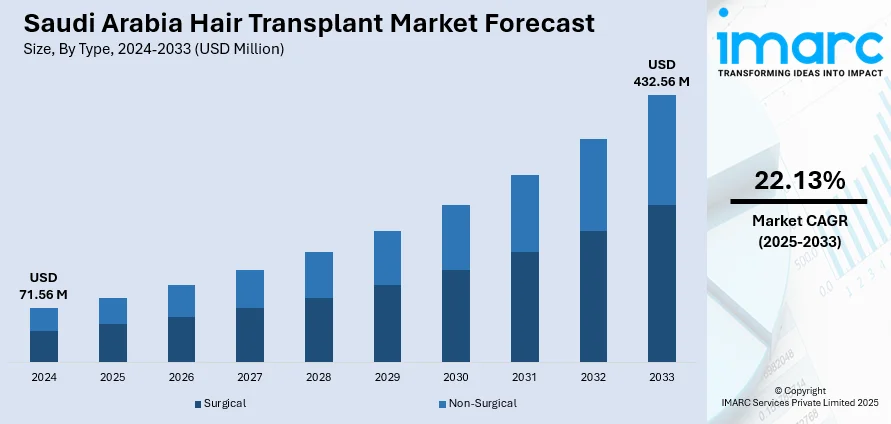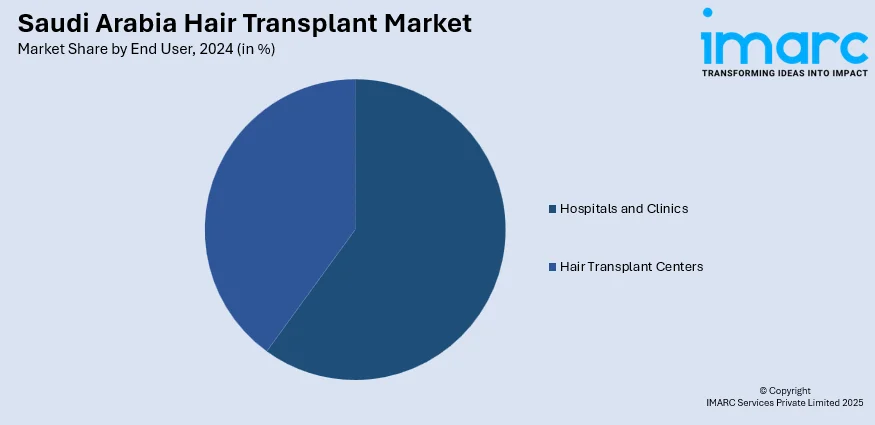
Saudi Arabia Hair Transplant Market Size, Share, Trends and Forecast by Type, Gender, End User, and Region, 2025-2033
Saudi Arabia Hair Transplant Market Overview:
The Saudi Arabia hair transplant market size reached USD 71.56 Million in 2024. Looking forward, IMARC Group expects the market to reach USD 432.56 Million by 2033, exhibiting a growth rate (CAGR) of 22.13% during 2025-2033. The market is driven by greater aesthetic awareness among younger adults, reinforced by personalized, privacy-conscious clinical services. Regional medical tourism is expanding, supported by specialized clinics aligned with international treatment standards, thereby fueling the market. A high prevalence of androgenetic alopecia is accelerating procedural demand, further augmenting the Saudi Arabia hair transplant market share.
|
Report Attribute
|
Key Statistics
|
|---|---|
|
Base Year
|
2024 |
|
Forecast Years
|
2025-2033
|
|
Historical Years
|
2019-2024
|
| Market Size in 2024 | USD 71.56 Million |
| Market Forecast in 2033 | USD 432.56 Million |
| Market Growth Rate 2025-2033 | 22.13% |
Saudi Arabia Hair Transplant Market Trends:
Increase in Male Grooming Culture
The growing trend of male grooming in Saudi Arabia, as more men are requesting aesthetic treatments to improve their looks, is offering a favorable market outlook. With the ongoing changes in global beauty standards and grooming trends, more men are seeking hair transplants as a viable remedy for hair loss or baldness. The urge to preserve a youthful and appealing look, once mainly linked to women, is now increasingly relevant for men too, broadening the possible clientele for the hair transplant sector. This change in mindset mirrors larger transformations in social standards, as cosmetic treatments for men are becoming more widely accepted. The General Authority for Statistics projects that Saudi Arabia's overall population will be 35.3 million by mid-2024, with males representing 62.1% of that total. This demographic shift indicates a growing need for hair restoration services, as more men look for methods to enhance their looks and elevate their self-esteem. The rising trend of male grooming significantly influences this change, providing clinics and healthcare providers with valuable opportunities to meet the growing need for hair transplants in Saudi Arabia.

To get more information on this market, Request Sample
Availability of Skilled Professionals
The availability of skilled medical professionals in Saudi Arabia significantly contributes to the ongoing expansion of the hair transplant industry. Over the years, Saudi Arabia has invested considerably in its healthcare infrastructure, particularly emphasizing advanced cosmetic and medical treatments. This is resulted in a continuous arrival of highly qualified professionals, many of whom have been educated at prestigious international medical institutions. The extensive expertise present guarantees that patients obtain advanced treatments with improved success rates. Clinics in Saudi Arabia can now provide hair transplant services that meet international standards, positioning the Kingdom as an appealing destination for local and foreign patients. Moreover, the growing pool of skilled experts is enhancing trust among clients, leading to greater confidence in pursuing hair restoration procedures. This trust is vital as patients place greater importance on quality, safety, and effective outcomes. The presence of highly skilled professionals ensures that those pursuing hair transplants receive top-notch treatment locally, eliminating the need for foreign travel, thereby contributing to the market growth.
Rise in Medical Tourism
Saudi Arabia is positioning itself as a primary choice for people from nearby areas and international markets in search of top-notch medical treatment, including cutting-edge hair restoration services, offered at attractive rates. With the ongoing increase in healthcare expenses in developed countries, a growing number of patients are seeking affordable and advanced hair transplant options in Saudi Arabia. The Kingdom boasts cutting-edge healthcare facilities and specialized clinics, providing innovative procedures conducted by highly trained experts. Reports from the IMARC Group, indicate that Saudi Arabia’s medical tourism sector hit USD 1,341.1 Million in 2024, demonstrating the increasing demand for quality healthcare services at more accessible prices. Saudi Arabia's outstanding healthcare services, along with competitive prices, is making it a favored destination for medical travelers. The arrival of international patients is supporting substantial expansion in the local healthcare industry, elevating the need for services like hair transplants and reinforcing the Kingdom’s status as a frontrunner in regional cosmetic procedures, especially in hair restoration.
Saudi Arabia Hair Transplant Market Growth Drivers:
Rising Awareness and Acceptance of Cosmetic Procedures
The rising awareness and acceptance of hair transplant surgeries among the masses represent a crucial factor bolstering the market growth in Saudi Arabia. Throughout the years, societal views on cosmetic enhancements have significantly changed, now regarded as essential components of self-care and individual wellness. Media channels, such as social media sites, ads, and celebrity endorsements, are pivotal in endorsing the safety and efficacy of hair transplant procedures. These platforms are contributing to the normalization of these practices, increasing their recognition and acceptance. In addition, the quest for enhanced aesthetics, along with higher self-awareness regarding physical appearance, is encouraging people to consider hair restoration alternatives. With the diminishing stigma around cosmetic treatments, a growing number of individuals are opting for cutting-edge procedures, such as hair transplants, to restore their self-esteem. This rising awareness, along with a better grasp of the advantages and outcomes of these treatments, continues to drive the market demand in Saudi Arabia.
Advancements in Hair Transplant Technology
The advancement of methods like follicular unit extraction (FUE) and robotic hair transplant technologies are resulting in less invasive, more efficient, and faster procedures, providing patients with better results. These advancements in technology are also leading to a decrease in recovery time, making the procedure more attractive to those looking for a less invasive solution to hair loss. As a result, patients are opting for modern techniques rather than conventional therapies as they offer a more natural appearance with reduced scarring. Moreover, the ongoing enhancement of these technologies are improving the overall patient experience by increasing the accuracy and effectiveness of hair restoration treatments. The extensive implementation of these advancements guarantees higher success rates and further enhances individual trust in the efficacy of hair transplants.
Growing Disposable Income
As the Kingdom’s economic situation gets better and living standards rise, people are increasingly willing to spend on cosmetic treatments that provide noticeable, enduring outcomes. This financial independence is resulting in a desire for cosmetic procedures such as hair transplants, as people prioritize improving their looks and enhancing self-esteem. According to the Mid-Year Economic and Fiscal Performance Report for FY 2024, private consumption expenditures saw an authentic increase of 2.4% in the first half of FY 2024 relative to the same period last year, indicating a transformation in consumer spending. The growing emphasis on wellness and self-care is leading to a broader trend, where individuals prioritize grooming and cosmetic treatments. With rising disposable income, the cost of hair transplants is becoming more manageable, allowing a larger segment of the population to access these services, thus contributing to the market growth.
Saudi Arabia Hair Transplant Market Segmentation:
IMARC Group provides an analysis of the key trends in each segment of the market, along with forecasts at the country and regional levels for 2025-2033. Our report has categorized the market based on type, gender, and end user.
Type Insights:
- Surgical
- Non-Surgical
The report has provided a detailed breakup and analysis of the market based on the type. This includes surgical and non-surgical.
Gender Insights:
- Male
- Female
The report has provided a detailed breakup and analysis of the market based on gender. This includes male and female.
End User Insights:

- Hospitals and Clinics
- Hair Transplant Centers
The report has provided a detailed breakup and analysis of the market based on end user. This includes hospitals and clinics and hair transplant centers.
Regional Insights:
- Northern and Central Region
- Western Region
- Eastern Region
- Southern Region
The report has also provided a comprehensive analysis of all major regional markets. This includes Northern and Central Region, Western Region, Eastern Region, and Southern Region.
Competitive Landscape:
The market research report has also provided a comprehensive analysis of the competitive landscape. Competitive analysis such as market structure, key player positioning, top winning strategies, competitive dashboard, and company evaluation quadrant has been covered in the report. Also, detailed profiles of all major companies have been provided.
Saudi Arabia Hair Transplant Market News:
- On February 19, 2025, Magrabi Health launched Mayam Aesthetics in Jeddah, Saudi Arabia, marking its entry into dermatology and aesthetic solutions. The facility offers a variety of services, including advanced hair treatments, hair transplants, skin injectables, and body contouring. In collaboration with DHI Global, Mayam Aesthetics aims to bring cutting-edge hair restoration treatments closer to home.
Saudi Arabia Hair Transplant Market Report Coverage:
| Report Features | Details |
|---|---|
| Base Year of the Analysis | 2024 |
| Historical Period | 2019-2024 |
| Forecast Period | 2025-2033 |
| Units | Million USD |
| Scope of the Report |
Exploration of Historical Trends and Market Outlook, Industry Catalysts and Challenges, Segment-Wise Historical and Future Market Assessment:
|
| Types Covered | Surgical, Non-Surgical |
| Genders Covered | Male, Female |
| End Users Covered | Hospital and Clinics, Hair Transplant Centers |
| Regions Covered | Northern and Central Region, Western Region, Eastern Region, Southern Region |
| Customization Scope | 10% Free Customization |
| Post-Sale Analyst Support | 10-12 Weeks |
| Delivery Format | PDF and Excel through Email (We can also provide the editable version of the report in PPT/Word format on special request) |
Key Benefits for Stakeholders:
- IMARC’s industry report offers a comprehensive quantitative analysis of various market segments, historical and current market trends, market forecasts, and dynamics of the Saudi Arabia hair transplant market from 2019-2033.
- The research report provides the latest information on the market drivers, challenges, and opportunities in the Saudi Arabia hair transplant market.
- Porter's five forces analysis assist stakeholders in assessing the impact of new entrants, competitive rivalry, supplier power, buyer power, and the threat of substitution. It helps stakeholders to analyze the level of competition within the Saudi Arabia hair transplant industry and its attractiveness.
- Competitive landscape allows stakeholders to understand their competitive environment and provides an insight into the current positions of key players in the market.
Key Questions Answered in This Report
The hair transplant market in Saudi Arabia was valued at USD 71.56 Million in 2024.
The Saudi Arabia hair transplant market is projected to exhibit a CAGR of 22.13% during 2025-2033, reaching a value of USD 432.56 Million by 2033.
The Saudi Arabia hair transplant market is primarily driven by increasing awareness about advanced cosmetic treatments, a growing demand for aesthetic enhancement, and rising disposable incomes. Additionally, the Kingdom’s robust healthcare infrastructure, coupled with a high preference for international medical standards, supports the market growth, making hair transplant services more accessible and appealing to individuals.
Need more help?
- Speak to our experienced analysts for insights on the current market scenarios.
- Include additional segments and countries to customize the report as per your requirement.
- Gain an unparalleled competitive advantage in your domain by understanding how to utilize the report and positively impacting your operations and revenue.
- For further assistance, please connect with our analysts.
 Request Customization
Request Customization
 Speak to an Analyst
Speak to an Analyst
 Request Brochure
Request Brochure
 Inquire Before Buying
Inquire Before Buying




.webp)




.webp)












